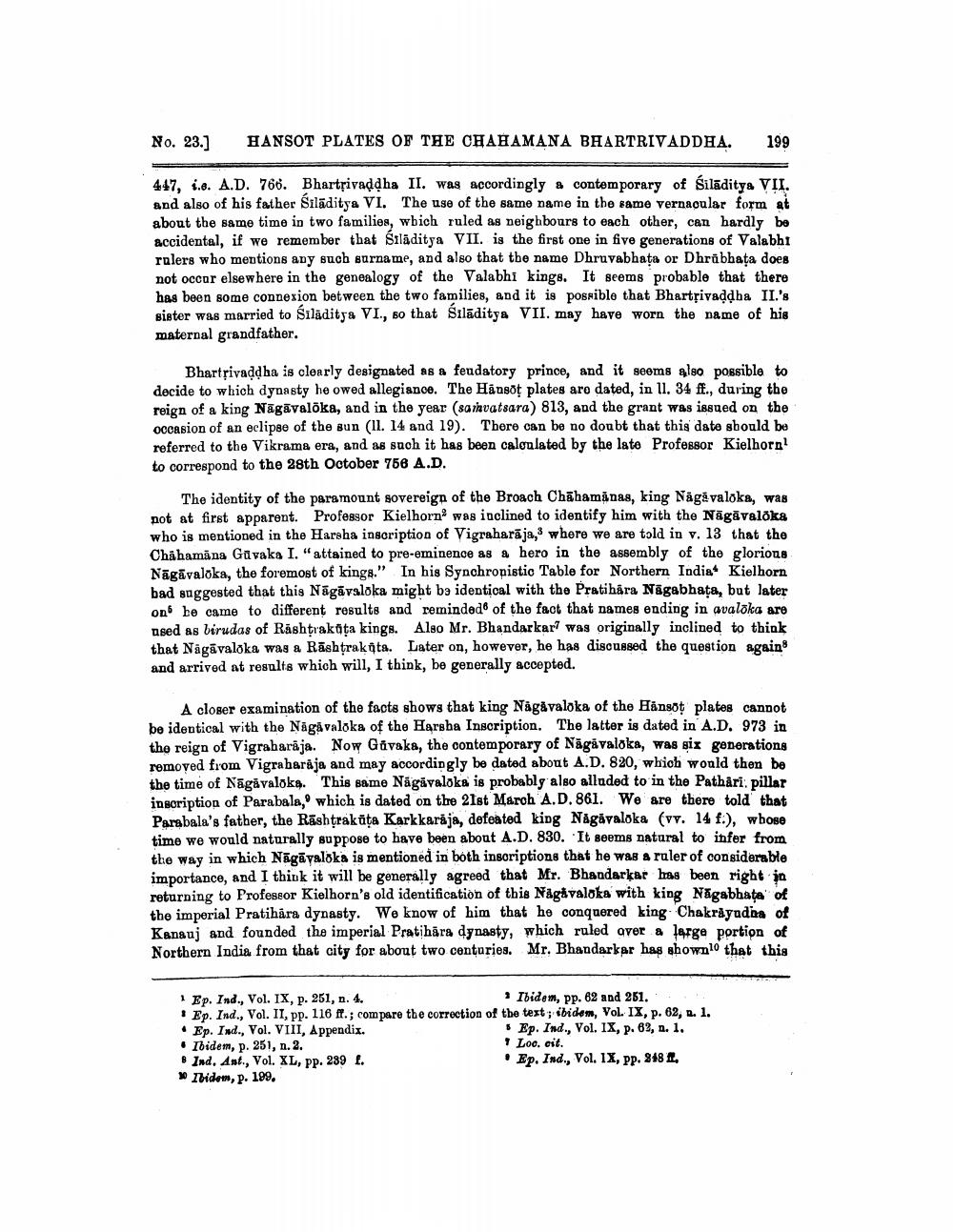________________
No. 23.)
HANSOT PLATES OF THE CHAHAMANA BHARTRIVADDHA.
199
447, 1.6. A.D. 760. Bhartsivaddha II. was accordingly & contemporary of silāditya VII. and also of his father Siladitya VI. The use of the same name in the same vernacular form at about the same time in two families, wbich ruled as neighbours to each other, can hardly be accidental, if we remember that Silāditya VII. is the first one in five generations of Valabhi rulers who mentions any such surname, and also that the name Dhruvabhata or Dhrubhata does not occur elsewhere in the genealogy of the Valabhi kings. It seems probable that there has been some connexion between the two families, and it is possible that Bhartsivaddha II.'s sister was married to Siladitya VI., so that Sılāditya VII. may have worn the name of his maternal grandfather.
Bhartsivaddha is clearly designated as a feudatory prince, and it seems also possible to decide to which dynasty he owed allegiance. The Hansot plates aro dated, in 11. 34 ff., during the reign of a king Nāgāvalóka, and in the year (samvatsara) 813, and the grant was issued on the Occasion of an eclipse of the sun (11. 14 and 19). There can be no doubt that this date should be referred to the Vikrama era, and as such it has been calonlated by the late Professor Kielhorn! to correspond to the 28th October 758 A.D.
The identity of the paramount sovereign of the Broach Chāhaminas, king Någåvaloka, was not at first apparent. Professor Kielhorn was inclined to identify him with the Nägāvaloka who is mentioned in the Harsha inscription of Vigraharāja, where we are told in v. 13 that the Chāhamāna Gavaka I. "attained to pre-eminence as a hero in the assembly of the glorions Nāgāvaloka, the foremost of kings." In his Synchropistic Table for Northern IndiaKielhorn bad suggested that this Nāgāvsloka might be identical with the Pratihara Nagabhata, but later on be came to different results and reminded of the fact that names ending in avaloka are ased as birudas of Rashtrakata kings. Also Mr. Bhandarkari was originally inclined to think that Nagāvaloka was a Rāshtrakta. Later on, however, he has discussed the question again and arrived at results which will, I think, be generally accepted.
A closer examination of the facts shows that king Någåvaloka of the Hansoţ plates cannot be identical with the Nāgávaloka of the Harsha Inscription. The latter is dated in A.D. 973 in the reign of Vigraharaja. Now Gavaka, the contemporary of Nāgāvaloka, was six generations removed from Vigrabaraja and may accordingly be dated about A.D. 820, whiob would then be the time of Nāgåvaloks. This same Nágávaloka is probably also alluded to in the Pathåri: pillar inscription of Parabala, which is dated on the 21st March A.D. 861. We are there told that Parabala's father, the Rishtrakūta Karkkaraja, defeated king Nagávaloka (vv. 14 f.), whose time we would naturally suppose to have been about A.D. 830. It seems natural to infer from the way in which Nigāyaloka is mentioned in both insoriptions that he was a ruler of considerable importance, and I think it will be generally agreed that Mr. Bhandarkar has been right in returning to Professor Kielhorn's old identification of this Någåvaloka with king Nagabhata of the imperial Pratihara dynasty. We know of him that he conquered king Chakrayudina of Kangaj and founded the imperial Pratihära dynasty, which ruled over a large portion of Northern India from that city for about two centuries. Mr. Bhandarkar has shown to that this
1 Ep. Ind., Vol. IX, p. 251, n. 4.
* Ibidem, pp. 62 and 261. 1 Ep. Ind., Vol. II, pp. 116 ff.; compare the correction of the text; ibidem, Vol. IX, p. 62, n. 1. • Ep. Ind., Vol. VIII, Appendix.
5 Ep. Ind., Vol. IX, p. 63, n. 1. • Ibidem, p. 251, n. 2.
* Loc. cit. 8 Ind. Ant., Vol. XL, pp. 289 E.
• Ep. Ind., Vol. IX, pp. 848. » Ibidea, p. 199.




